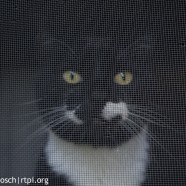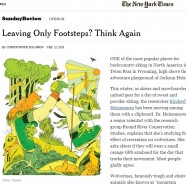Scrunchies for Cats?
Apparently all we need to do is take old hair scrunchies and put them on cats to halve their slaughter of native wildlife? It makes sense, certainly, but the cat is still at extreme or even greater risk of injury and death by being that much more noticeable to both its prey and predators, not to mention it getting stuck on something and trapped…and it should still be in the house. Always. I also cannot imagine any cat I have ever owned putting up with this for more than a few minutes… Scott Kruitbosch Conservation & Outreach Coordinator
Read MoreRecord Shattering Cold & Historic Snow
To be entirely honest I meant to write this blog entry a couple of weeks ago. Yes, I have been busy during that time with meetings, gearing up for spring and summer projects, surveying, and much more. Nevertheless, I could not get myself too excited to write about the unbelievably and astonishingly historic cold we have had this winter, especially in February, or the feet of snow dumped on the region, rewriting more records for some locations. After feeling the first signs of spring in the past week I feel renewed, ready for the thaw and once again energized about our weather and climate....
Read More“Leaving Only Footsteps? Think Again”
Here’s an interesting opinion piece in the New York Times that details how even passive recreation can have an unexpectedly high impact on wildlife. These are all issues we as scientists have dealt with at one time or another, from how placement of trails in preserves is vital to protect certain species and the fact they create unsuitable edge habitat, how passive recreation activities like hiking can have negative impacts in the same way something like snowmobiling could (or more, as they can occur in all seasons and not just winter), and that a day at the beach disrupts birds like...
Read MoreGray Fox (Urocyon cinereoargenteus)
Have you figured out the answer to our mystery woodland creature post yet? Do you give up? Well, that little mammal that was sitting behind all the brush is in fact a Gray Fox (Urocyon cinereoargenteus)! Although the Gray and Red Fox share the same family and some similar colorations, there are several distinct differences that separate these relatives. For starters, Gray Fox are called gray for a reason. Their coat is short and the fur down their back and tail are dark gray, ending with black at the tip of the tail. Compared to the Red Fox, and many other North American canids, Gray Fox are...
Read MoreNew CLICK Program in Panama
With this storm settling down, Twan and I are preparing for our return to Panama tomorrow (hopefully). We are assisting with a new program this year called CLICK, and its goal is to assist rural villages in Panama to protect the biodiversity around them. High school students from the Marvelwood School in Kent, Connecticut will work with children from the rural village of La Zahina in eastern Panama along with Lauren Bowers (daughter of Marvelwood Alum Chuck Bowers) to document the wildlife in their “backyards” and around the Cocobolo Nature Reserve in order to better understand and help...
Read More








